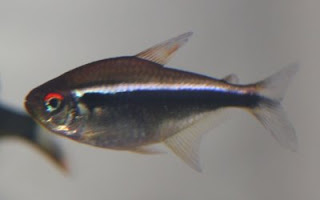Introduction
This tetra is olive-green on the dorsal surface and silvery on the belly.There is an iridescent ,pale green-blue line along the flanks, from the top of the eye to the caudal peduncle. Below this, a dark area gradually pales towards the lower part of the body.Fins are mostly colorless, and an adipose fin is present.Females gradually have deeper bodies and increase in girth at spawning times.
Common Name
Black Tetra, Neon Tetra
Species
Hyphessobrycon herbertaxelrodi
Habitat
Streams and rivers in the Mato Grosso region of Brazil.
Maximum Size
About 1.75"(4.5cm).
Minimum Tank Size
A tank measuring at least 18" x 12" x 12" (45cm x 30cm x 30cm) - 42 litres.
Diet
Easy to feed. It will readily accept just about anything offered.They are Omnivorous , so can eat most of the foods.In the aquarium it proves unfussy. Feed a mixture of dried flakes and granules along with small live and frozen foods.
Water Temperature
72-82°F (22-28°C)
pH
5.5-7.5.
Hardness
2-10°H
Remark
Soft, acid water will bring out this fish color.





























































